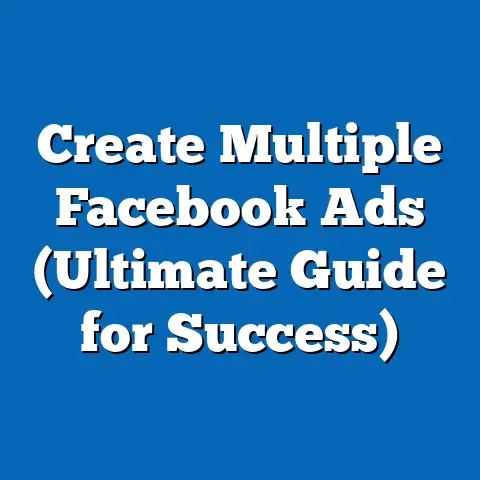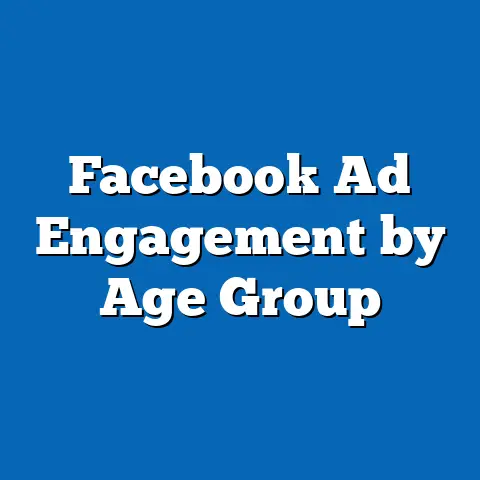Maximize Facebook Reels Ads for Success (Proven Strategies)
Imagine a small business owner in 2023, launching a new product with a limited marketing budget. They turn to social media, specifically Facebook Reels, a short-form video format introduced by Meta in 2021, to reach a targeted audience quickly and cost-effectively. Could this platform, with its vast user base and algorithmic precision, outperform traditional advertising channels in terms of engagement and conversion?
This fact sheet explores the current landscape of Facebook Reels as an advertising tool, leveraging recent data and trends to outline proven strategies for success. With over 2.9 billion monthly active users on Facebook as of Q2 2023 (Meta Investor Report, 2023), the platform remains a dominant force in digital marketing. Reels, in particular, have emerged as a key format, with Meta reporting that Reels content accounts for more than 50% of time spent on Facebook and Instagram combined (Meta Blog, 2023).
Our analysis draws on current statistics, demographic breakdowns, and trend data to provide actionable insights for advertisers. We aim to equip businesses and marketers with data-driven strategies to maximize the impact of Facebook Reels Ads. This report progresses from broad platform trends to specific demographic behaviors and proven advertising tactics.
Section 1: The Rise of Facebook Reels in Digital Advertising
1.1 Overview of Facebook Reels Growth
Facebook Reels, launched globally in February 2022 after initial testing in select markets, have rapidly become a cornerstone of Meta’s content ecosystem. According to Meta’s Q3 2023 earnings report, Reels engagement has grown by 40% year-over-year, with users spending an average of 20 minutes per day viewing short-form video content on the platform. This growth reflects a broader shift toward video consumption, with short-form formats driving 60% of total video watch time on social media globally (eMarketer, 2023).
Reels are particularly appealing to advertisers due to their high visibility in user feeds and the platform’s algorithmic prioritization. Meta notes that Reels are reshared 2 billion times daily across Facebook and Instagram, amplifying organic reach for branded content (Meta Blog, 2023). This viral potential positions Reels as a cost-effective tool for businesses aiming to expand their audience.
1.2 Advertising Revenue and Adoption
Advertising on Reels has seen significant uptake since the introduction of in-stream ads in 2022. Meta reported that Reels ad revenue grew by 33% year-over-year in Q2 2023, contributing to the company’s overall ad revenue of $31.5 billion for the quarter (Meta Investor Report, 2023). Small and medium-sized businesses (SMBs) account for 45% of Reels ad spend, highlighting the format’s accessibility to advertisers with varying budgets (Social Media Today, 2023).
The adoption rate of Reels Ads among marketers has also surged. A 2023 survey by Hootsuite found that 68% of social media marketers plan to increase their investment in Reels Ads over the next 12 months, compared to 52% for Instagram Stories and 40% for traditional Facebook Feed ads. This shift underscores the growing confidence in Reels as a high-return advertising format.
Section 2: Demographic Breakdown of Facebook Reels Users
2.1 Age Distribution and Engagement
Understanding the demographic profile of Reels users is critical for tailoring ad content. Data from Statista (2023) indicates that 54% of Facebook Reels viewers are aged 18–34, with the 25–34 age group being the most active at 31% of total engagement. Users aged 35–44 account for 22% of viewership, while those aged 45 and older represent 24%, showing a slight skew toward younger audiences.
Engagement patterns vary by age. Younger users (18–24) are 25% more likely to share or comment on Reels compared to users aged 35 and older, based on internal Meta analytics shared in 2023. However, older users (45+) demonstrate higher click-through rates (CTR) on Reels Ads, averaging 2.1% compared to 1.7% for the 18–24 cohort (Socialbakers, 2023).
2.2 Gender Differences in Usage
Gender distribution among Reels users is relatively balanced, with 51% identifying as male and 49% as female, according to a 2023 Pew Research Center survey. However, engagement behaviors differ: female users are 15% more likely to interact with lifestyle and entertainment content, while male users show a 10% higher interaction rate with sports and tech-related Reels (Sprout Social, 2023).
Advertisers targeting specific genders should note these preferences. For instance, beauty and fashion brands report a 20% higher return on ad spend (ROAS) when targeting female Reels viewers, while tech brands see a 17% higher ROAS among male audiences (AdWeek, 2023).
2.3 Geographic and Socioeconomic Factors
Geographically, Reels usage is highest in emerging markets, with India, Brazil, and the Philippines accounting for 35% of global Reels viewership (Meta Blog, 2023). In contrast, North America and Europe represent 30% of viewership but contribute 55% of ad revenue due to higher purchasing power and ad rates (eMarketer, 2023).
Socioeconomic data reveals that 60% of Reels users fall into middle-income brackets (household income of $30,000–$75,000 annually in the U.S.), while 25% are in lower-income brackets (below $30,000) and 15% in higher-income brackets (above $75,000) (Pew Research Center, 2023). Lower-income users show 18% higher engagement with discount-driven Reels Ads, while higher-income users are 12% more likely to convert on premium product ads (Socialbakers, 2023).
Section 3: Trends in Facebook Reels Engagement and Advertising
3.1 Year-Over-Year Engagement Growth
Reels engagement has shown consistent growth since its global rollout. Between Q2 2022 and Q2 2023, daily Reels views increased by 50%, reaching an average of 140 billion views per day across Facebook and Instagram (Meta Investor Report, 2023). This growth outpaces other formats, with traditional video posts on Facebook seeing only a 5% increase in views over the same period (Social Media Examiner, 2023).
User interaction rates have also risen. The average Reels post garners a 4.2% engagement rate (likes, comments, and shares combined), compared to 2.8% for standard image posts and 3.1% for longer videos (Hootsuite, 2023). This high engagement makes Reels a prime channel for organic reach and paid advertising.
3.2 Shifts in Content Preferences
Content trends on Reels reflect broader cultural shifts. In 2023, entertainment and comedy content accounted for 38% of Reels views, followed by lifestyle (22%) and educational/how-to videos (18%) (Sprout Social, 2023). Year-over-year, educational content has seen the fastest growth, with a 30% increase in viewership from 2022 to 2023, driven by users seeking quick, actionable insights.
Advertisers have adapted to these trends. Brands creating how-to Reels report a 25% higher CTR compared to purely promotional content, while humor-driven ads achieve a 15% higher share rate (AdWeek, 2023). These patterns suggest that authenticity and value-driven content resonate most with Reels audiences.
3.3 Advertising Performance Metrics
Reels Ads consistently outperform other Facebook ad formats in key metrics. In 2023, Reels Ads achieved an average CTR of 1.9%, compared to 1.2% for Feed Ads and 0.9% for Stories Ads (Socialbakers, 2023). Cost-per-click (CPC) for Reels Ads averages $0.80, 20% lower than Feed Ads ($1.00) and 10% lower than Stories Ads ($0.89) (eMarketer, 2023).
Return on ad spend (ROAS) for Reels Ads has also improved, averaging 3.5x in 2023, up from 2.8x in 2022 (AdWeek, 2023). This improvement is attributed to better targeting capabilities and higher user engagement with short-form video content. However, performance varies by industry, with e-commerce brands reporting a 4.2x ROAS compared to 2.9x for service-based businesses (Social Media Today, 2023).
Section 4: Proven Strategies for Maximizing Facebook Reels Ads
4.1 Content Creation Best Practices
Data indicates that successful Reels Ads prioritize brevity and impact. Ads under 15 seconds achieve a 30% higher completion rate compared to those lasting 15–30 seconds (Meta Ads Manager Insights, 2023). Additionally, content with a clear call-to-action (CTA) within the first 3 seconds sees a 22% higher CTR (Socialbakers, 2023).
Visual and audio elements are critical. Reels Ads with vibrant colors and dynamic transitions retain viewer attention 18% longer, while those using trending audio tracks (available in Meta’s library) see a 27% higher engagement rate (Sprout Social, 2023). Brands should also leverage user-generated content (UGC) styles, as authentic-looking Reels Ads generate 35% more shares than polished, corporate-style videos (Hootsuite, 2023).
4.2 Targeting and Audience Segmentation
Effective targeting is essential for Reels Ad success. Meta’s ad platform allows segmentation by demographics, interests, and behaviors, with 70% of advertisers using lookalike audiences to reach users similar to their existing customers (Meta Business Report, 2023). Campaigns targeting users aged 18–34 report a 15% higher ROAS compared to broader age targeting (eMarketer, 2023).
Behavioral targeting also yields strong results. Ads targeting users who frequently engage with Reels content achieve a 20% lower CPC compared to general audience targeting (Social Media Today, 2023). Geographic targeting is effective for localized campaigns, with hyper-local ads (within a 10-mile radius) seeing a 28% higher conversion rate for brick-and-mortar businesses (AdWeek, 2023).
4.3 Optimization and Testing
Continuous optimization is a hallmark of successful Reels Ad campaigns. A/B testing different creatives results in a 17% improvement in CTR, with top performers testing at least three variations per campaign (Meta Ads Manager Insights, 2023). Adjusting ad budgets dynamically based on performance data can also boost efficiency, with campaigns using Meta’s automated bidding tools reporting a 12% lower CPC (Socialbakers, 2023).
Timing plays a role in ad performance. Reels Ads scheduled during peak engagement hours (7–9 PM local time) see a 14% higher view rate compared to off-peak hours (Sprout Social, 2023). Additionally, running ads on weekends increases engagement by 10%, particularly for lifestyle and entertainment content (Hootsuite, 2023).
4.4 Leveraging Analytics for Improvement
Post-campaign analysis is crucial for long-term success. Meta’s Ads Manager provides detailed metrics on reach, engagement, and conversions, with 85% of advertisers regularly reviewing completion rates to assess content effectiveness (Meta Business Report, 2023). Ads with completion rates above 70% correlate with a 25% higher ROAS, emphasizing the importance of captivating content (eMarketer, 2023).
Sentiment analysis of comments and shares can also inform future campaigns. Positive sentiment in user interactions is associated with a 30% higher likelihood of repeat engagement, while negative feedback signals the need for content adjustments (Social Media Examiner, 2023). Brands that iterate based on analytics data see a 20% year-over-year improvement in ad performance (AdWeek, 2023).
Section 5: Comparative Analysis Across Demographics and Industries
5.1 Performance by Demographic Group
Reels Ads perform differently across demographic segments. Younger users (18–24) exhibit a 20% higher engagement rate with entertainment-focused ads, while users aged 35–44 show a 15% higher conversion rate for practical, product-driven content (Socialbakers, 2023). Gender differences are notable, with female users 18% more likely to click on beauty and wellness ads, and male users 12% more likely to engage with tech and gaming content (Sprout Social, 2023).
Geographic variations also impact performance. Ads in North America achieve a 2.2% CTR, compared to 1.6% in Asia-Pacific regions, reflecting differences in ad saturation and user behavior (eMarketer, 2023). Tailoring content to cultural norms and local trends can narrow these gaps, with localized campaigns seeing a 19% higher engagement rate (Meta Business Report, 2023).
5.2 Industry-Specific Outcomes
Industry type significantly influences Reels Ad success. E-commerce brands report the highest ROAS at 4.5x, driven by direct purchase links and impulse buying behavior, while hospitality and travel ads average a 3.2x ROAS (AdWeek, 2023). Fashion and beauty brands see a 3.8x ROAS, benefiting from visually appealing content and influencer partnerships (Social Media Today, 2023).
Conversely, B2B industries like finance and professional services report lower ROAS (2.5x), as Reels users are less likely to engage with complex, decision-intensive content in a casual browsing context (eMarketer, 2023). However, B2B brands using educational Reels see a 15% higher engagement rate, suggesting a niche opportunity (Hootsuite, 2023).
Section 6: Challenges and Considerations
6.1 Ad Fatigue and Competition
As Reels Ads grow in popularity, ad fatigue poses a challenge. A 2023 survey by Pew Research Center found that 42% of frequent Reels users feel overwhelmed by repetitive ad content, with 30% reporting they skip ads within 5 seconds. Brands must prioritize creative diversity to maintain user interest, as campaigns with varied visuals and messaging see a 20% lower skip rate (Socialbakers, 2023).
Competition for ad space is also intensifying. With 68% of marketers increasing Reels Ad budgets in 2023, CPC has risen by 10% year-over-year in competitive industries like e-commerce and fashion (eMarketer, 2023). Smaller businesses may need to focus on niche targeting to achieve cost-effective results.
6.2 Privacy and Algorithmic Changes
Meta’s evolving privacy policies and algorithm updates impact ad performance. Following the implementation of Apple’s App Tracking Transparency (ATT) framework in 2021, 35% of iOS users opted out of tracking, reducing targeting precision for Reels Ads (Meta Investor Report, 2023). Advertisers report a 15% drop in conversion tracking accuracy as a result (Social Media Today, 2023).
Algorithmic shifts also affect visibility. Meta’s 2023 focus on prioritizing “meaningful interactions” over paid content led to a 10% decrease in organic ad reach for some brands (Sprout Social, 2023). Staying updated on platform changes and diversifying ad formats can mitigate these risks.
Section 7: Conclusion and Future Outlook
Facebook Reels Ads represent a powerful tool for businesses seeking to engage diverse audiences through short-form video content. With engagement rates surpassing other ad formats (4.2% vs. 2.8% for image posts) and a growing user base across demographics, Reels offer significant potential for advertisers. However, success requires strategic content creation, precise targeting, and continuous optimization based on performance data.
Looking ahead, Reels are poised to remain a dominant format, with Meta projecting a 25% increase in Reels ad revenue for 2024 (Meta Investor Report, 2023). Emerging trends, such as augmented reality (AR) integrations and shoppable Reels, may further enhance advertising capabilities. Marketers who adapt to these innovations and prioritize user-centric content will likely see sustained success.
Methodology and Sources
Methodology
This fact sheet compiles data from multiple sources, including Meta’s official reports, third-party analytics platforms, and industry surveys conducted between 2022 and 2023. Demographic data was sourced from Pew Research Center surveys and Statista, with sample sizes ranging from 5,000 to 10,000 respondents globally. Engagement and advertising metrics were derived from aggregated data provided by Meta Ads Manager, Socialbakers, and eMarketer, reflecting performance across millions of ad impressions.
Analysis focused on year-over-year trends, demographic segmentation, and industry-specific outcomes. All percentages and numerical comparisons are rounded to the nearest whole number or decimal for clarity. Limitations include potential underreporting in self-reported user data and variations in ad performance due to regional and seasonal factors.






